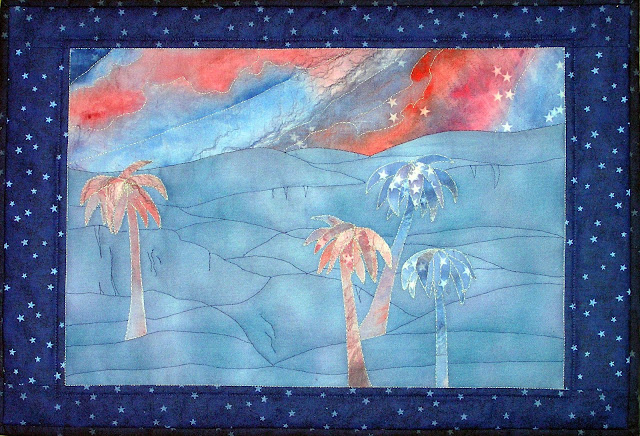Sailing at the
Farm; A Paper Bag Challenge
April 2017
Lois/Joan/Julie
Collaboration
Never
turn down anything chocolate - or anything quilt related when the challenge
gauntlet is thrown down. This quilt is
the end result of one our “paper bag” challenges at our guild. The challenge works like this. One quilter fills a paper bag with some fabric scraps and
notions. Whoever gets the bag has to
make a small quilt using the contents. They’re allowed to add their own thread
and imagination, nothing else. At least a piece of every fabric or item in
the bag must be used. To add to the fun the
bag contains a whole bunch of alarmingly unharmonious fabrics. Some people love this challenge. Most are neutral. The rest would rather have their hair set on
fire.
Last fall Lois
was charged with coming up with a challenge. When she revealed the two paper
bags, everyone in the room either looked at the floor or suddenly noticed
something of spellbinding interest in their purse. To be fair, everyone already had at least one
too many projects in their queue. I
wanted to grab one of the bags right away, but I hated to appear greedy. I’d done this type of challenge before (Light
and Dark in the City). It was time to let someone else to have a chance.
It took a
while for the two bags to get picked up. Both went to people who volunteered an
absent member for the project. Hint: never
miss a meeting. One bag got passed
around, and eventually it reached my friend Joan. She did the background
and then became the victim of evaporated enthusiasm. She set it aside. We kicked around some ideas, but I could see
she’d already moved on. The quilt got added to her pile of unfinished
projects, with the fabric-in-waiting and the things that were no longer as much
fun as when they were started. If you are a quilter, you know this
feeling well. Projects that once tapped you on the shoulder while you were
sleeping and dragged you to your machine at six a.m. eventually became dreary. You start thinking about breaking up with
them.
I offered to
take this one and finish it under the pretense of heroism, but the truth was I’d
wanted to do one of these all along.
And, since the background was completed, all the heavy lifting had
already been done. All I had to do was
swoop in and find the story.
 There were
some blue and white blocks in the bag that hadn’t been used yet. Turning them on point, I recognized their
true calling. They were sail boats! I added grey strips to the water, and added
more grey fabric at the bottom of the quilt. I reduced the size of the
sky. A beautiful day for sailing emerged.
There were
some blue and white blocks in the bag that hadn’t been used yet. Turning them on point, I recognized their
true calling. They were sail boats! I added grey strips to the water, and added
more grey fabric at the bottom of the quilt. I reduced the size of the
sky. A beautiful day for sailing emerged.  From the bag, I added the flowers (buttons)
and used the 3 colours of embroidery floss for stems and leaves. The unseen farmer was way instantly way happier
with his little house by the sea.
From the bag, I added the flowers (buttons)
and used the 3 colours of embroidery floss for stems and leaves. The unseen farmer was way instantly way happier
with his little house by the sea.
Finally, I machine quilted it with metallic
thread in the water and sky. I would never normally have added a light
coloured binding, but that was the only fabric left that was big enough. Surprisingly,
it made the piece look like a snapshot of a farm by the sea. There was still
one jarring piece of brown fabric left. It
fell into conflict with every other fabric in the quilt. I used it on the back
as a border for the label. No one had
specified exactly where the fabric
had to be used.
And the
fate of this quilt? It will find a whole
new home as the door prize someone will win at our upcoming quilt show.
















